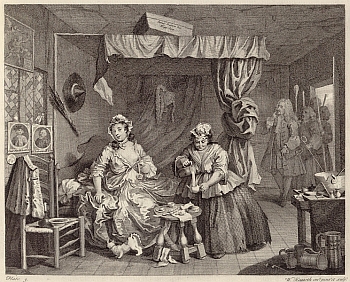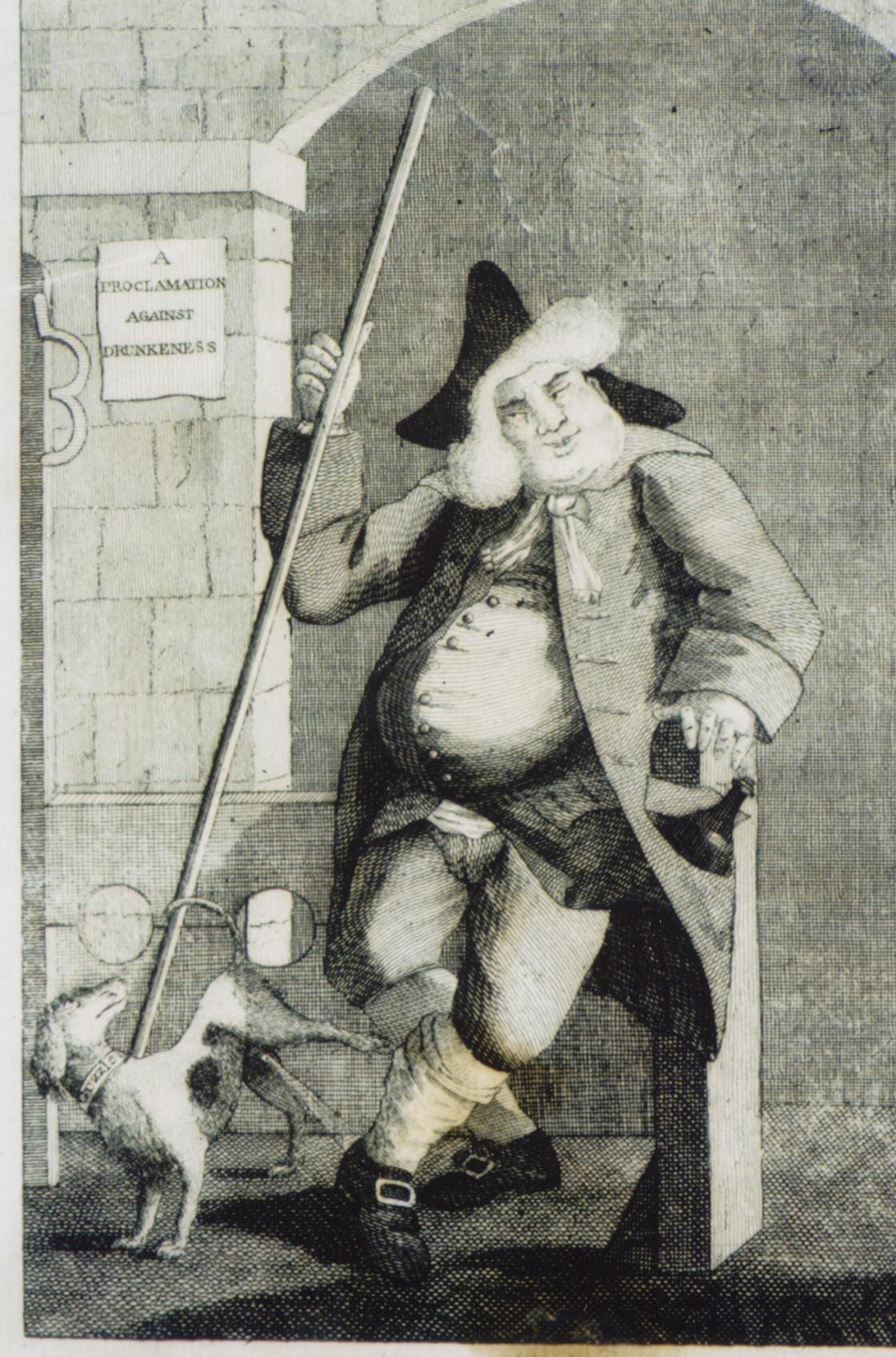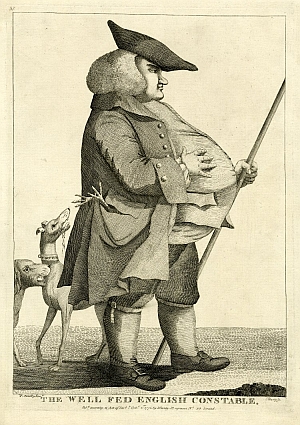Reformation of Manners Campaigns
 William Hogarth. Apprehended by a Magistrate.A Harlot's Progress. Plate III. April 1732. © London Lives.
William Hogarth. Apprehended by a Magistrate.A Harlot's Progress. Plate III. April 1732. © London Lives.
Introduction
Largely reliant on private prosecutions, the early modern criminal justice system did not facilitate the prosecution of large numbers of victimless offences such as immorality and irreligion. But despite increasing religious toleration, England in the eighteenth century remained a strongly Protestant country, and many people were offended by public displays of sin, not least because it was thought that such conduct led sinners down a slippery slope of increasingly criminal conduct which would lead inevitably to the gallows.
The eighteenth century was the first great age of voluntary societies, and concerns about vice led to the formation, over the course of the century, of successive societies which aimed to suppress immorality. While members sought to promote reform through persuasion, in sermons and through the distribution of printed literature, they saw the need for coercion as well. With the Church Courts in decline, the reformers turned to the criminal justice system. Their methods attracted significant opposition, however, and the reformers frequently found themselves at the receiving end of often vexatious litigation aimed at undermining their activities. Ultimately, attempts to use the law to promote a reformation of manners were frustrated by a combination of both legal and popular opposition. The records included in this website provide evidence of both the reformers' activities and the opposition they engendered.
The First Societies, 1690-1738
The first Societies for a Reformation of Manners were formed in 1690, shortly after the Revolution of 1688 placed William and Mary on the throne. England, it was argued, had narrowly averted the catastrophe of a Catholic monarch, and it was imperative to clean up public life before God imposed even more draconian punishments on the nation. The Societies, led by prominent politicians and religious leaders, sought and received the support of the King and Queen, who issued proclamations of support, and of magistrates in the City of London and Middlesex.
In addition to producing an extensive range of printed pamphlets, the Societies sought to prevent vice by using the courts aggressively to punish those who committed a range of offences, including profane swearing and cursing, sabbath breaking, drunkenness, "lewd and disorderly" conduct, brothel keeping, gaming and sodomy. Because ordinary people and even officers such as constables could not be counted on to prosecute such offenders, the reformers encouraged informers, some of whom were paid a salary, to take up the mantle. A few men became very active in the cause, notably Bodenham Rewse and James Jenkins. Both were paid officers of the Societies in 1693-94, thus raising the question of whether they were motivated more by financial gain than by religious zeal. As was the case with many informers, both later became thief-takers.1 By, to some extent, taking over the role of policing from private citizens and overseeing the activities of parish officers, these informers contributed to the professionalisation of policing.2 Unsurprisingly, their attempts to systematically prosecute vice generated widespread opposition.
While many of their prosecutions were documented in records which no longer survive, or are not included on this website, some of the informers' activities can be found in the Bridewell Court of Governors' Minute books (MG) (committals of prostitutes) and the Sessions Papers (PS) (certificates of conviction for swearing and cursing).
Under the umbrella of the reformation of manners campaign a wide variety of illegal activities were prosecuted, as supporters and Justices of the Peace viewed the campaign as a useful means of addressing wider problems of crime and disorder in the metropolis. From the late 1690s to the 1720s informers and thief-takers waged a campaign against homosexuality, using spies and provocateurs to arrest and prosecute dozens of men for sodomy, some of whom were hanged. In 1725, the Middlesex Justices began to investigate gin drinking among the poor, and, along with pressure from the Middlesex grand jury and others, this led in 1729 to the first of a series of statutes passed against gin selling over the next three decades. In the early 1730s, led by Justice John Gonson, the Westminster Justices waged a campaign against "disorderly houses" in Westminster, targetting a group of offenders centred around Mary Harvey.3
But faced with numerous legal obstacles to the activities of their informers, the number of offenders prosecuted by the Societies declined significantly after 1725. In 1736 widespread opposition to the use of informers to enforce the Gin Act dealt the Societies a death blow, and they disappeared from the historical record in 1738, only to reappear in a different form some twenty years later.
 A Reforming Constable. c.1765. © Westminster Archives Centre.
A Reforming Constable. c.1765. © Westminster Archives Centre.
1757-63 Society
The impetus for reform did not wholly disappear in the 1740s and early 1750s. Vestry Minutes (MV) for the parish of St Clement Danes demonstrate that parish officials discussed methods of suppressing disorderly houses, curtailing the sale of spirituous liquors, enforcing the laws against the profanation of the Sabbath, and arresting prostitutes. But no voluntary society formed again to encourage such activity.
In 1757, prompted by concerns about crime, luxury and social degradation, a combined group of churchmen, dissenters, and Methodists, supported by Justice John Fielding and the City, Middlesex and Westminster Sessions, was formed to suppress Sabbath breaking, later expanding to campaign against swearing, gambling, and prostitution. Having first tried to change behaviour through the distribution of printed pamphlets, in 1758 they began prosecuting offenders. According to John Wesley, by August 1762 they had brought 9,596 prosecutions, and in the following seven months 992 more people were brought to trial, 550 for lewdness and keeping a brothel, 400 for sabbath breaking, and 40 for gaming and profane swearing.4 One of their most active informers was William Payne. A vexatious lawsuit against the Society in 1763, explained in the next section, brought this short-lived campaign to a sudden end.
Opposition to Informers and Reforming Constables
From their earliest days, informers encountered hostility because they were seen to be profiting from other people's misery. In the seventeenth century, this antagonism applied to those prosecuting economic offenders and, in the 1670s, to those involved in suppressing religious conventicles. By the the time the Societies for a Reformation of Manners began to use them in the 1690s, therefore, informers already had a bad reputation, and their zealous prosecutions of those engaged in various forms of vice were unlikely to be welcomed by the accused. In some cases, men and women were even arrested in brothels during the very act of sexual intercourse. Popular antagonism was heightened whenever there was even a hint of corruption, or entrapment, surrounding their activities. The fact that many of the informers refused to accept any part of the fines which were due to them did not save them from attack.
Opposition took a number of forms. Most directly, informers and constables were frequently assaulted and subjected to riotous attacks. Two reforming constables in the early eighteenth century were killed while apprehending offenders. In 1721, two informers who had arrested "lewd women" were threatened by a Justice of the Peace at the head of a large mob, and forced to leave the parish.
The informers and Justices who attempted to enforce the 1736 Gin Act were subjected to even greater violence. During the lifetime of the Act informers were subject to fifty-seven attacks, and four were beaten to death. There were at least nine occasions when crowds gathered in front of a Justice's house or the Excise Office, and one case, in front of the house of Middlesex Court Justice Thomas De Veil, involved up to one thousand rioters.5
The reformers were also frequently subject to vexatious prosecutions, which caused a serious drain on the Societies' funds. With the assistance of solicitors and barristers keen to make a profit, keepers of brothels and even ordinary prostitutes were often able to procure false witnesses and prosecute their accusers for assault, false imprisonment, perjury and extortion. Even if these prosecutions failed, they were costly and time-consuming to defend. Nineteen of the sixty-three most active informers (30 per cent) who initiated prosecutions under the 1736 Gin Act were subjected to counter-prosecutions, seven for extortion and twelve for perjury. Remarkably, virtually all (seventeen) were convicted.6 These prosecutions were extremely damaging for both the reformers' reputations and their finances. In 1763 the prosecution of reforming constables on a charge of assaulting and falsely imprisoning the keeper of a supposed brothel led to the award £300 damages against the reformers. Even though they subsequently successfully convicted one of the prosecution witnesses of perjury, the high cost of this litigation effectively ended the mid-century reformation of manners campaign.
 Paul Sandby. The Well Fed English Constable. October 1777. This is almost certainly a depiction of William Payne, as it is similar to known satires of him. British Museum, BM Satires 4641. © Trustees of the British Museum.
Paul Sandby. The Well Fed English Constable. October 1777. This is almost certainly a depiction of William Payne, as it is similar to known satires of him. British Museum, BM Satires 4641. © Trustees of the British Museum.
These criticisms, physical attacks, and vexatious challenges demoralized informers and contributed to the repeated failure of reformation of manners campaigns. Informers, afraid of "incurring the odious name of informer",7 stopped informing. Justices of the Peace became extremely cautious when hearing cases brought by informers, demanding higher standards of evidence before they would convict and frequently discouraging informers from bringing cases before them. Consequently, the 1736 Gin Act became unenforceable. When parliament repealed the Act in 1743, it noted that "great difficulties and inconveniences have attended the putting the said act in execution" 8
Legal Opposition
Those who challenged prosecutions against vice were not always motivated by a simple desire to protect their allegedly sinful practices. Much of the opposition to reformation of manners campaigns actually arose out of a concern to protect judicial discretion and ensure legal safeguards. While informers sought to prosecute the law systematically against all offenders, legal practices were designed to allow magistrates the discretion to determine verdicts and punishments according to the individual circumstances of each case. Informers' practices fell afoul of evolving judicial principles in the following ways:
- defendants should be able to respond to allegations against them. The practice of Justices of the Peace convicting defendants summarily of offences such as working on Sunday without giving the accused the chance to respond was ruled illegal: even if they were working on the Sabbath, there may have been extenuating circumstances which made such behaviour acceptable, and the accused had to be summoned and given the opportunity to respond to the charge.
- a specific offence and instance of illegal behaviour should be charged. The practice of convicting women of prostitution simply on the basis of their reputation, or the fact they were arrested walking the streets at times and in places where prostitutes were known to frequent, was deemed unacceptable. Charges of being "loose, idle and disorderly" were increasingly vulnerable to challenge unless a specific form of misbehaviour was alleged.
- arrest warrants should specify the precise person to be apprehended, or type of offender, and a return date. In 1725, the practice of issuing general warrants authorising constables to arrest those guilty of a range of illegal behaviour was rejected, leading to an immediate drop in prosecutions initiated by the reformers.
As a result of these and other legal challenges, it became increasingly difficult to prosecute men and women for adultery and fornication in the eighteenth century. Not only did a specific allegation of misconduct need to be proved, but sexual incontinence per se was increasingly deemed outside the purview of the criminal law--only when it led to an offence against the peace (as with the case of a disorderly brothel) was it deemed culpable. Consequently, many allegations of street walking and similar offences were dismissed when brought before the magistrates.
The Proclamation Society, 1787
The difficulties of prosecuting vice were well known when, at the instigation of William Wilberforce and others, King George III was persuaded in 1787 to issue a proclamation against drunkenness, gaming, profane swearing and cursing, lewdness, profanation of the sabbath, "or other dissolute, immoral, or disorderly practices".9 The 1780s had witnessed the Gordon Riots, a perceived crime wave, and associated fears of social upheaval, and, according to conventional understandings of the causes of crime and disorder, widespread immorality was to blame. But while a campaign against vice was an entirely conventional response to social problems, lessons had been learned from previous campaigns, and the tactics used this time were far less dependant on an aggressive use of the criminal justice system.
The campaign "was marked by tactical caution",10 as efforts were targeted at convincing sinners to reform or, if that failed, encouraging existing legal officials to carry out their responsibilities more rigorously. This is not surprising when we consider that arrested offenders were likely to be discharged without punishment, unless their behaviour was "outrageous and overt".11 There were attempts to enact new laws, get reforming magistrates appointed, and energise magistrates by disseminating information about points of law. But unlike earlier societies, informers were used sparingly. Rather than prosecute large numbers of offenders, supporters relied on high profile prosecutions of a small number of "examples" as a means of discouraging vice. Nonetheless, once again the reformers were subjected to vexatious prosecutions. It is perhaps significant that this reformation of manners society diversified into other areas of reform where they were less likely to encounter popular opposition: inspecting prisons, setting up a philanthropic society, and, eventually, transforming itself into the Society for Bettering the Condition of the Poor. Popular and legal opposition to the systematic prosecution of vice had led to a transformation of the reformers' strategies and tactics.
It is true that the early nineteenth-century Vice Society (founded in 1802) brought large numbers of prosecutions, but these were primarily for profanation of the Sabbath, and few prostitutes were punished. Once again, their use of paid agents and volunteers to initiate prosecutions attracted criticism from both magistrates and the public, and the prosecutors were forced to compromise in many cases and drop prosecutions if the accused promised to reform. And like its predecessor, the Vice Society also engaged in a number of philanthropic activities. This was unquestionably the future when it came to addressing the problem of prostitution: the Guardian Society, founded in 1815, strove to reclaim prostitutes, particularly "fallen" underage girls. In 1825, the Society for the Suppression of Vice acknowledged the government's reluctance to prosecute prostitutes, given public hostility to such prosecutions.12
Exemplary Lives
Lives using the keywords Reformation of Manners:
Introductory Reading
- Dabhoiwala, Faramerz. Sex and Societies for Moral Reform, 1688-1800. Journal of British Studies, 46:2 (2007), pp. 290-319.
- Innes, Joanna. Politics and Morals: The Reformation of Manners Movement in Later Eighteenth-Century England. In Hellmuth, Eckhart ed., The Transformation of Political Culture: England and Germany in the Late Eighteenth Century. Oxford and New York, 1990, pp. 57-118.
- Roberts, M. J. D. Making English Morals: Voluntary Association and Moral Reform in England, 1787-1886. Cambridge, 2004.
- Shoemaker, Robert B. Reforming the City: The Reformation of Manners Campaign in London, 1690-1738. In Davison, L., et al., eds, Stilling the Grumbling Hive: The Response to Social and Economic Problems in England, 1689-1750. Stroud and New York, 1992, pp. 99-120.
- Warner, Jessica and Ivis, Frank. "Damn you, you informing bitch": Vox Populi and the Unmaking of the Gin Act of 1736. Journal of Social History, 33 (1999), pp. 299-330.
For further reading on this subject see the London Lives Bibliography
Footnotes
1 Tim Wales, Rewse, Bodenham (d. 1725), Oxford Dictionary of National Biography (requires subscription), consulted 27 April 2010. ⇑
2 Faramerz Dabhoiwala, Sex, Social Relations and the Law in Seventeenth- and Eighteenth-Century London, in Michael Braddick, and John Walter, eds, Negotiating Power in Early Modern Society: Order, Hierarchy and Subordination in Britain and Ireland (Cambridge, 2001), p. 100. ⇑
3 Heather Shore, 'The Reckoning': Disorderly Women, Informing Constables, and the Westminster Justices, 1727-33, Social History, 34 (2009), pp. 409-27. ⇑
4 John Wesley, Works (1958), vol. 6, p. 154. ⇑
5 Jessica Warner and Frank Ivis, "Damn you, you informing bitch": Vox Populi and the Unmaking of the Gin Act of 1736, Journal of Social History, 33 (1999), p. 309. ⇑
6 Jessica Warner, Frank Ivis and Andree Demers, A Predatory Social Structure: Informers in Westminster, 1737-1741, Journal of Interdisciplinary History, 30 (2000), pp. 630-31. ⇑
7 Saunders Welch, An Essay on the Office of Constable (1758), p. 32. ⇑
8 Warner and Ivis, "Damn you, you informing bitch", p. 320. ⇑
9 London Gazette, issue 12890, 29 May 1787. ⇑
10 Joanna Innes, Politics and Morals: The Reformation of Manners Movement in Later Eighteenth-Century England, in Eckhart Hellmuth, ed., The Transformation of Political Culture: England and Germany in the Late Eighteenth Century (Oxford and New York, 1990), p. 75. ⇑
11 Drew D. Gray, Crime, Prosecution and Social Relations: The Summary Courts of the City of London in the Late Eighteenth Century (Basingstoke, 2009), p. 131. ⇑
12 Leon Radzinowicz, A History of English Criminal Law and its Administration From 1750. Vol. 3, Cross-currents in the Movement for Reform of the Police (1956). p. 160. ⇑


